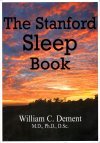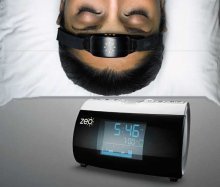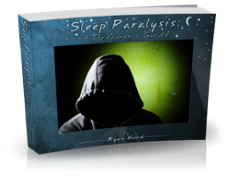
| Connect & Subscribe |
Sleepwalking Brochure
An Outreach Project by Alysha Shivji | Return To Outreach Projects 2010
The following is a brochure created for Stanford Sleep and Dreams. If it is difficult to read using the images, you may view the text here.
Also feel free to download this brochure for distributional or general information purposes. Please refer to our privacy policy for our relevant disclaimers.
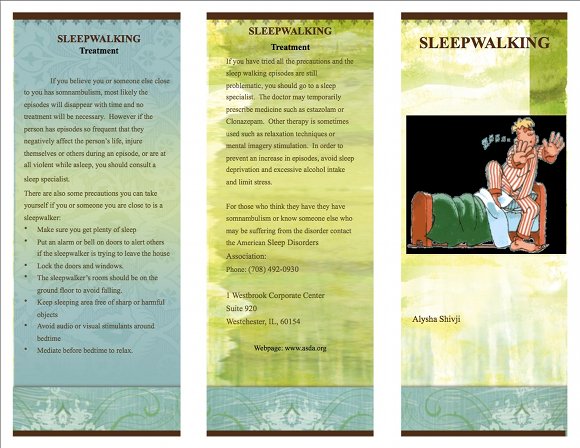
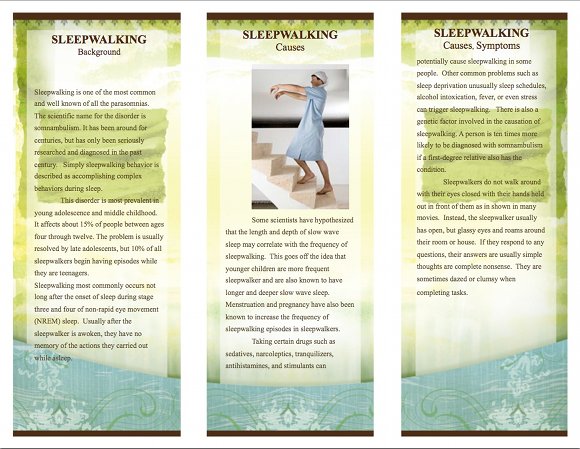
Treatment
If you believe you or someone else close to you has somnambulism, most likely the episodes will disappear with time and no treatment will be necessary. However if the person has episodes so frequent that they negatively affect the person's life, injure themselves or others during an episode, or are at all violent while asleep, you should consult a sleep specialist. There are also some precautions you can take yourself if you or someone you are close to is a sleepwalker:
If you have tried all the precautions and the sleep walking episodes are still problematic, you should go to a sleep specialist. The doctor may temporarily prescribe medicine such as estazolam or Clonazepam. Other therapy is sometimes used such as relaxation techniques or mental imagery stimulation. In order to prevent an increase in episodes, avoid sleep deprivation and excessive alcohol intake and limit stress.
For those who think they have they have somnambulism or know someone else who may be suffering from the disorder contact the American Sleep Disorders Association: Phone: (708) 492-0930
1 Westbrook Corporate Center
Suite 920
Westchester, IL, 60154
Webpage: www.asda.org
Background
Sleepwalking is one of the most common and well known of all the parasomnias. The scientific name for the disorder is somnambulism. It has been around for centuries, but has only been seriously researched and diagnosed in the past century. Simply sleepwalking behavior is described as accomplishing complex behaviors during sleep.
This disorder is most prevalent in young adolescence and middle childhood. It affects about 15% of people between ages four through twelve. The problem is usually resolved by late adolescents, but 10% of all sleepwalkers begin having episodes while they are teenagers.
Sleepwalking most commonly occurs not long after the onset of sleep during stage three and four of non-rapid eye movement (NREM) sleep. Usually after the sleepwalker is awoken, they have no memory of the actions they carried out while asleep.
Causes, Symptoms
Some scientists have hypothesized that the length and depth of slow wave sleep may correlate with the frequency of sleepwalking. This goes off the idea that younger children are more frequent sleepwalker and are also known to have longer and deeper slow wave sleep. Menstruation and pregnancy have also been known to increase the frequency of sleepwalking episodes in sleepwalkers.
Taking certain drugs such as sedatives, narcoleptics, tranquilizers, antihistamines, and stimulants can potentially cause sleepwalking in some people. Other common problems such as sleep deprivation unusually sleep schedules, alcohol intoxication, fever, or even stress can trigger sleepwalking. There is also a genetic factor involved in the causation of sleepwalking. A person is ten times more likely to be diagnosed with somnambulism if a first-degree relative also has the condition.
Sleepwalkers do not walk around with their eyes closed with their hands held out in front of them as in shown in many movies. Instead, the sleepwalker usually has open, but glassy eyes and roams around their room or house. If they respond to any questions, their answers are usually simple thoughts are complete nonsense. They are sometimes dazed or clumsy when completing tasks.
About This Site
Welcome! This site is continuously being created by students of Dr. William C. Dement's Sleep And Dreams course at Stanford University.
We made this site as a call to action for people all over the world to live healthier, happier, safer, and more productive lives by learning about their own sleep. We have faith that reading the information provided on this site will motivate you to be smart about your sleep deprivation and strategic about your alertness in order to live life to your fullest, most energetic potential.
In fact, we challenge you to do so! What do you say, are you up for the challenge?
Interviews With Sleep Specialists: Insights Into the Worlds of Sleep Medicine & Sleep Business
America's Most Dangerous Disorder: What Is Sleep Apnea Doing To Your Sleep?
Sleep Debt: How Much More Will You Achieve When You Reduce Yours?
The Stages Of Sleep: The Journey Through The Night
Delayed Sleep Phase: You Want To Sleep But You're Not Tired Yet
Paralyzed at Night: Is Sleep Paralysis Normal?
Sleep In Words: Smart, Strange, and Funny Quotes About Sleep
Sleep Disorders In Children: What's Keeping Your Child From A Full Night's Rest?
Attacks of Pavor Nocturnus (a.k.a. Sleep Terrors, Night Terrors, or Incubus Attacks)
The Stanford Sleep Book
Dr. Dement's pioneering textbook has been the core text for Sleep and Dreams since 1980, but it has just recently been made available to the wider public for the first time.
In it you'll find a more detailed account of the most important things you need to know about sleep, alertness, dreams, and sleep disorders. Studies, statistics, plus plenty of Dr. Dement's classic anecdotes painting the history of sleep medicine.
Preface | Intro | Contents | Get A Copy
More Sleep Resources
The Zeo
A revolution in personal sleep tracking, the Zeo is a wireless headband that transmits your brainwaves in realtime to a dock (pictured here) or your smartphone. The result? You can wake up and see exactly what stages of sleep you were in during the night! Unprecedented personalized sleep knowledge.
Sleep Paralysis: A Dreamer's Guide
Ever woken up paralyzed? A surprising number of us have, believe it or not. But few know the actual causes of this phenomenon, and fewer still how to exert control over it. Dream researcher and sleep paralysis expert Ryan Hurd shares breakthrough insights into how to do just that.
Important Disclaimer
Please Note:
The information found on this page and throughout this site is intended for general information purposes only. While it may prove useful and empowering, it is NOT intended as a substitute for the expertise and judgments of healthcare practitioners.
For more info, see our
Terms of Use.







